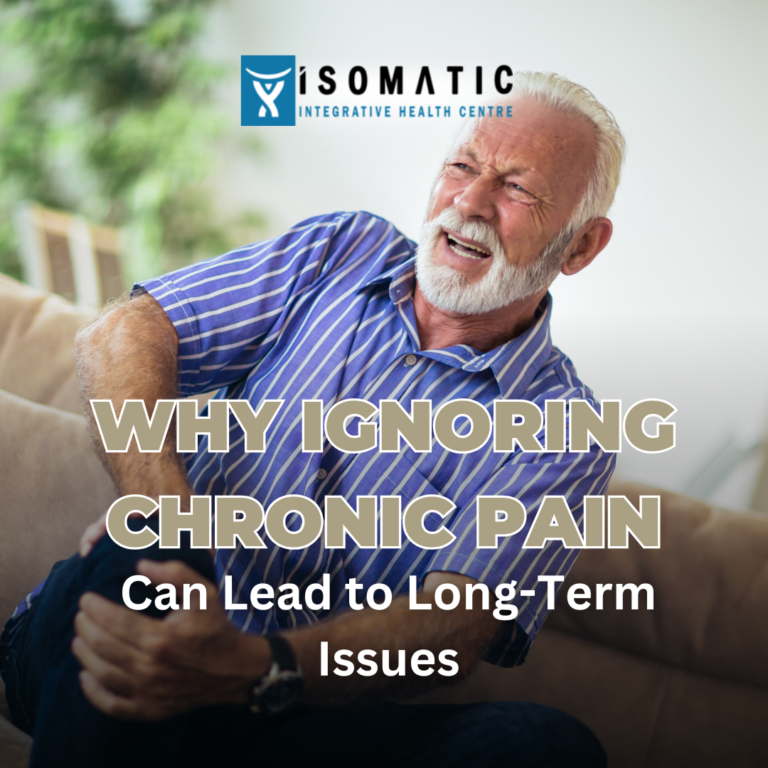Chronic pain is a signal, not a sentence. Ignoring it won’t make it disappear—but confronting it can set you on a path to healing and wholeness. Whether your pain is new or old, mild or severe—pay attention. Your future self will thank you.
Why Ignoring Chronic Pain Can Lead to Long-Term Issues

Chronic Pain: A Silent Epidemic
Chronic pain, though often invisible, is anything but harmless. Millions silently endure it daily, brushing it off as “normal” or “not bad enough.” However, ignoring chronic pain can lead to long-term issues that compound with time, affecting every facet of life. From physical deterioration to emotional turmoil and financial burdens, the price of silence is far too steep.
Let’s explore what chronic pain truly is and why early intervention can be a life-changing—and even life-saving—decision.
What Is Chronic Pain?
Chronic pain is defined as persistent pain that lasts for more than 12 weeks, even after the initial injury or illness has healed. Unlike acute pain, which acts as a warning sign of injury, chronic pain lingers. It often becomes a condition in and of itself, requiring dedicated treatment.
It can stem from arthritis, fibromyalgia, nerve damage, or no identifiable cause at all. It’s not merely a symptom; it’s a condition that hijacks daily living.
Common Causes of Chronic Pain
Chronic pain doesn’t come out of nowhere. While some people develop it due to accidents or surgery, others encounter it from degenerative diseases like:
Osteoarthritis
Rheumatoid arthritis
Herniated discs
Neuropathy
Migraines
Sometimes, unresolved emotional trauma or chronic stress can manifest physically, making pain a multidimensional condition.
The Difference Between Acute and Chronic Pain
It’s essential to distinguish between the two:
| Type | Duration | Cause | Treatment |
|---|---|---|---|
| Acute | Short-term (less than 3 months) | Injury, surgery | Heals with time |
| Chronic | Long-term (more than 3 months) | Underlying condition or unknown | Requires ongoing management |
Ignoring acute pain can allow it to evolve into chronic pain, turning a temporary problem into a lasting challenge.
How Chronic Pain Affects the Body Over Time
When left untreated, chronic pain doesn’t just stay in one area—it spreads its effects throughout the body. Muscles weaken from disuse, posture degrades, and even internal organs feel the strain. Over time, this can lead to systemic issues and compounding damage.
Moreover, persistent pain alters the brain’s pain-processing pathways, creating a vicious cycle of sensitivity and discomfort known as central sensitization.
Muscle Atrophy and Reduced Mobility
One of the most immediate consequences is limited movement. When pain discourages you from using a muscle group, it weakens. Over time:
Muscle fibers shrink
Flexibility declines
Balance worsens
The risk of falls increases
Reduced mobility leads to further pain and disability—a downward spiral.
Nerve Damage and Sensory Loss
Chronic pain from conditions like sciatica or diabetic neuropathy can lead to:
Numbness
Tingling
Burning sensations
Permanent nerve damage
This isn’t just discomfort—it’s the body misfiring vital signals, often permanently.
The Link Between Chronic Pain and Depression
The longer pain persists, the more it affects the mind. Studies show a bidirectional relationship between pain and depression. The burden of constant discomfort can erode mental health, causing:
Hopelessness
Lack of motivation
Emotional detachment
Suicidal thoughts in extreme cases
Addressing one without the other rarely yields results—both require care.
How Chronic Pain Triggers Anxiety Disorders
Anxiety thrives in uncertainty—and chronic pain brings plenty. People with ongoing pain often fear its return, leading to:
Panic attacks
Hypervigilance
Avoidance behaviors
Social withdrawal
This mental toll can sometimes outweigh the physical pain itself.
Sleep Disturbances and Cognitive Decline
Sleep is healing, but pain disrupts rest. Over time, sleep deprivation leads to:
Memory issues
Irritability
Poor decision-making
Weakened immunity
Even a few nights of poor sleep due to pain can impair brain function. Long-term? The effects compound alarmingly.
Chronic Pain and Cardiovascular Strain
The body under stress releases cortisol and adrenaline, hormones that increase blood pressure and heart rate. When this response becomes chronic, it leads to:
Hypertension
Heart disease
Increased risk of stroke
Pain is not just inconvenient—it’s a cardiovascular risk factor.
Immune System Suppression
Chronic pain suppresses the immune system, making it harder for your body to fight infections or recover from illness. This leads to:
Frequent colds
Slow wound healing
Increased autoimmune responses
In simple terms, your body stays in survival mode—and breaks down faster.
Digestive and Metabolic Disruption
Pain doesn’t stop at the nerves. It can impact digestion, too. People with chronic pain often suffer from:
IBS (Irritable Bowel Syndrome)
Acid reflux
Sluggish metabolism
Unwanted weight changes
A neglected gut can spiral into bigger health issues down the road.
Social Isolation and Relationship Breakdown
People in pain often retreat from friends, family, and social events. This isolation can lead to:
Feelings of loneliness
Misunderstandings with loved ones
Strained marriages
Loss of friendships
You may not mean to push people away—but pain often does it for you.
Workplace Challenges and Career Limitations
Chronic pain affects job performance. You might face:
Absenteeism
Reduced productivity
Demotions or job loss
Forced early retirement
This not only damages self-worth but also affects long-term financial stability.
Substance Abuse Risks
Without proper treatment, many turn to:
Alcohol
Prescription painkillers
Recreational drugs
What begins as pain relief can quickly lead to addiction. Managing pain must be supervised by professionals to avoid dependency.
Denial and Stigma
Many ignore pain because they’re told to “toughen up.” Others fear being labeled dramatic. But denial doesn’t cure pain. It only allows it to worsen silently.
Lack of Access to Healthcare
Some delay seeking care due to:
Lack of insurance
High medical costs
Limited nearby specialists
Yet early investment in treatment usually costs far less than long-term consequences.
Fear of Diagnosis or Cost
Ironically, fear of discovering a serious issue can lead to ignoring mild symptoms. But the earlier you know, the more options you have—and the better the outcome.
Financial Burden of Delayed Treatment
Pain doesn’t stop at the nerves. It can impact digestion, too. People with chronic pain often suffer from:
IBS (Irritable Bowel Syndrome)
Acid reflux
Sluggish metabolism
Unwanted weight changes
A neglected gut can spiral into bigger health issues down the road.
Escalating Medical Needs Over Time
What might have been managed with physical therapy could now require surgery. Left unchecked, pain often snowballs into chronic disease.
Impact on Quality of Life
Chronic pain touches every moment—from waking to sleeping. When life becomes about avoiding pain, joy takes a backseat.
Recognizing the Warning Signs
If pain is:
Persistent
Interfering with daily life
Accompanied by other symptoms
…it’s time to see a professional. The sooner, the better.
The Role of General Practitioners and Specialists
A general practitioner can offer referrals, diagnostics, and basic management. But chronic pain may also require:
Rheumatologists
Neurologists
Pain management specialists
An integrated care approach works best.
Physical Therapy and Rehabilitation
Physiotherapists help retrain your body to move correctly. They use:
Manual therapy
Targeted exercises
Posture correction
Mobility improvement
It’s not always comfortable—but it’s often essential.
Mind-Body Approaches: Yoga, Meditation, CBT
Pain affects the mind—so treat the mind:
Yoga reduces stiffness and builds strength.
Mindfulness teaches pain acceptance.
CBT (Cognitive Behavioral Therapy) reframes pain responses.
These methods can reduce reliance on medication.
FAQs
How can I tell if my pain is chronic?
If your pain lasts more than three months, affects your daily activities, or keeps coming back—it’s likely chronic.
Can untreated chronic pain cause permanent damage?
Yes. It can lead to nerve damage, muscular atrophy, mental health decline, and more.
Is medication always required?
Not always. Many manage pain with physical therapy, diet, and mental health strategies.
How do I talk to my doctor about chronic pain?
Be honest. Track symptoms, describe intensity, and mention impacts on life quality.
What natural remedies actually help?
Exercise, anti-inflammatory diets, yoga, and meditation show great promise.
Can stress really make chronic pain worse?
Absolutely. Stress amplifies pain signals and reduces your ability to cope.
Conclusion
Discover how we can help you today. Contact us to book your first appointment.
Related Posts

Can Physiotherapy Improve Your Immune System?
December 9, 2025
Can Physiotherapy Improve Your Immune System? Most people think of physiotherapy as treatment for injuries, pain, or movement limitations—but its benefits extend far beyond rehabilitation.

Headaches and Tension? Try These Hands-On Osteopathic Solutions
December 2, 2025
Headaches and Tension? Try These Hands-On Osteopathic Solutions Headaches caused by tension can be draining, distracting, and downright frustrating. Whether they come from long hours

Isometric Exercises: Why We Recommend Them in Recovery
November 25, 2025
Isometric Exercises: Why We Recommend Them in Recovery When you’re healing from an injury, not all exercises are safe—some movements can even set you back.
